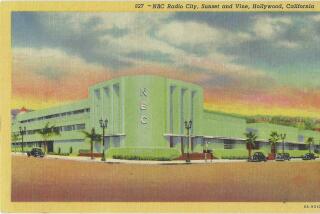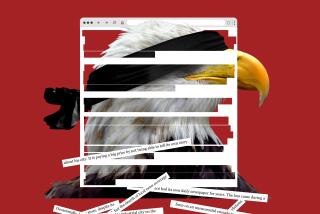MEDIA : Radio’s New Golden Age Is Sparkling in San Diego
- Share via
Picture the San Diego radio industry as an armadillo, plodding along, its thick shell making it seemingly impervious to outside dangers. Except now the creature is an 80-pound, steroid-chomping monster armadillo, the beast of armadillodom.
At least, that’s the way local radio executives feel these days. In the past year, San Diego radio industry advertising revenues increased by 20%, according to a recent study.
“Out of the 73 markets nationwide that we monitored, San Diego showed the highest increase,” said George Nadel Rivin, partner in charge of broadcast services for the accounting firm of Miller, Kaplan, Arase & Co.
The radio biz has been booming throughout the country, but the national average for growth was a relatively feeble 8% last year, according to Nadel Rivin’s report. San Diego outpaced both Los Angeles and San Francisco, which posted gains closer to 16%.
After years of puttering along, showing regular if unspectacular increases, San Diego radio stations totaled about $80 million in revenues in 1988.
“When I came here in 1972, the radio market was doing closer to $7 million,” KFMB vice president and general manager Paul Palmer said.
In this era of cable TV and home video, when radio was supposed to fade into a forgotten sister role, there are several explanations for the dramatic increase. With the television market becoming more fractionalized, radio is still able to target specific audiences in a relatively cost-effective manner.
In general, last year was an election year, and that always generates political advertising dollars for stations, and the stock market crash forced many businesses to rethink their advertising budgets, Nadel Rivin said.
In San Diego, the rapidly growing economy is, of course, a big factor. Last month, Advertising Age magazine listed San Diego second in the nation in terms of gross media revenues per household.
Local radio is also benefiting from increasing congestion on San Diego freeways. People listen to their radios when they’re sitting in their cars.
“Commuting times have almost doubled,” KYXY-FM (96.5) general manager Jim Price said.
Looking at the bigger picture, everyone seems to agree that radio executives are simply doing a better job.
“The quality of the sales operations has dramatically improved,” said Palmer, the new president of the San Diego Broadcasters Assn. “There are better salespeople representing the industry.”
The increase in revenues the past few years has sparked the well-documented radio station buying frenzy currently sweeping the country, perhaps best illustrated by the Pac Man approach of the locally based Noble Broadcasting, which increased its portfolio of stations to 18 in recent years.
Last week, a Dallas-based firm spent $55 million to buy KFAC-FM, a classical station in Los Angeles, which basically means that any station capable of sending out a signal is worth big bucks. In 1986, Classic Communications spent $33.5 million for both KFAC AM and FM.
“Broadcasters have come to the conclusion that we have started into a new golden age,” said Price.
Former San Diego Mayor Roger Hedgecock went into the Channel 10 studio Wednesday night to tape the first installment of his new television show, focusing on border problems. However, the next day--Hedgecock says it was at his request--Channel 10 agreed to tape another “first” show next week, this one focusing on racial tension in San Diego. The first try clearly didn’t cut it. Both Hedgecock and the station thought the race issue would be more timely and controversial for the all-important first show, set to air Feb. 5. Channel 10 says the border show will air at a later date.
The folks at Airwatch Traffic have opened up a similar traffic reporting business in Orange County called Air Traffic Communications. They go on the air today with four stations, including KRLA-AM (1110). . . . Cynthia Heath Kerrigan has rejoined the San Diego Airwatch staff on a full-time basis. Her deejay role with KCBQ (Eagle 105) has gradually diminished in the past year, after she was booted from the morning show six months ago. She will continue to do weekend and fill-in shifts for the station.
Former Padres announcer Dave Campbell says he interviewed for a job with the Montreal Expos but didn’t get it. That has been his only interview since being dumped by the Padres. His old friend Phil Stone helped out by arranging for Campbell to do six San Diego State football and baseball games for KUSI-TV (Channel 51). There is one game remaining on the contract. . . . It’s hard to imagine any video cheesier than KGTV (Channel 10) reporter Jim Wilkerson’s report on a luxury cruise ship. Reveling in the freebie, he reported on the ship’s toilets. After flushing for the cameras, he crowed, “Man that’s technology!”. . . . Bordering on the extremely cheesy but perhaps merely tacky was Channel 39 leading its 11 p.m. newscast Thursday with a lengthy report on audience reaction (they loved it) to Channel 39’s own show “Third Thursday,” which aired earlier that evening.
Several KNSD-TV (Channel 39) staffers reportedly attended a party Saturday night celebrating “36 years of Channel 39,” honoring recently dumped employees Doug Curlee (14 years with the station), Whitney Southwick (13 years) and Hal Gray (9 years). . . . Inadvertently omitted from The Times listing of Golden Mike winners Monday was the KPBS-FM (89.5) radio team of Karen Kish, Shamsi Varshochi and Michael Fraser, who took home honors in the Best Radio Feature Reporting category for “Bluegrass Family” . . . KPBS-FM executive producer Mike Starling has accepted a two-month consulting gig with the Swaziland (South Africa) Broadcasting and Information Service.
KVSD-AM (1000) staffers were not thrilled when they received a memo Tuesday telling them not to mention Michael Reagan’s new gig with rival news station KSDO-AM (1130). In response, they spent the morning telling listeners they were not going to mention Michael Reagan--over and over again.
More to Read
Sign up for Essential California
The most important California stories and recommendations in your inbox every morning.
You may occasionally receive promotional content from the Los Angeles Times.










